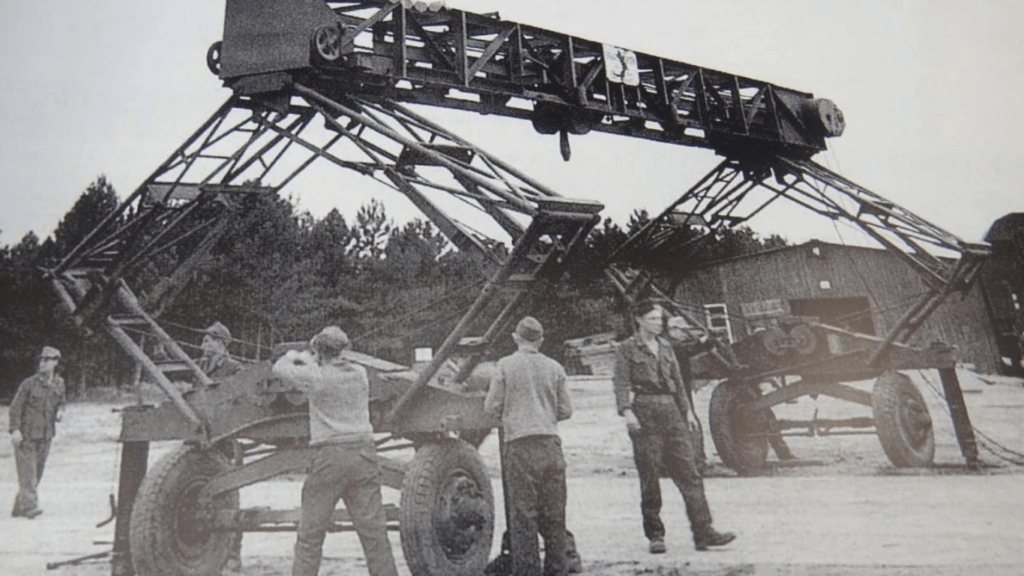The WW2 German railway gantry crane was a marvel of wartime innovation and logistics engineering. Designed during the Second World War, these cranes played a pivotal role in supporting the German military’s needs.
Their primary purpose was to manage supply lines, lift heavy loads, and ensure the efficient transportation of critical military equipment like tanks, artillery, and other essential supplies.
They operated across challenging environments, serving as a vital asset for maintaining the momentum of the German war effort.
This article explores their origin, design, functionality, operational role, and lasting legacy, showcasing how these cranes influenced both the war and modern engineering.
The Origin and History of the WW2 German Railway Gantry Crane
The German railway gantry crane emerged from the urgent demands of the Second World War. The war presented a monumental task for the German military: managing extensive supply lines over vast areas under immense pressure. Traditional methods of transporting artillery, tanks, and other supplies were no longer sufficient.
The introduction of the gantry crane revolutionized wartime logistics. Built to operate on railway tracks, these cranes could lift and transport massive objects quickly and efficiently.
Positioned at military stations and along key railway lines, they addressed critical military needs by ensuring that supplies reached the front lines without delay.
Their role was vital in overcoming logistical challenges, making them an indispensable part of the German military strategy.
The Design and Functionality of the WW2 German Railway Gantry Crane
The design of the WW2 German railway gantry crane was a testament to engineering ingenuity. These massive machines, towering over railway tracks, were built with size and weight in mind. They featured a sturdy frame and robust wheels to provide stability while handling heavy loads.
A key component of the crane was its lifting mechanism, which was powered by either steam engines or electrical systems.
This mechanism enabled the cranes to lift hundreds of tons of cargo, making them capable of handling even the largest military vehicles and equipment. The crane’s arm, designed to extend and reach, allowed for the precise loading and unloading of supplies.
Another critical feature was their mobility. Mounted on special railway cars, the cranes could travel along rail lines, ensuring their efficiency and speed. As highlighted by Pedrovazpaulo Business Consultant, the modular and adaptable design of these cranes was a groundbreaking approach to wartime logistics.
Their ability to transport heavy-duty cargoes was instrumental in the success of the German war effort, as it allowed for the rapid movement of critical supplies.
The Operational Role of the WW2 German Railway Gantry Crane
The operational role of the German railway gantry cranes was essential for maintaining the logistical efficiency of the German military.
These cranes were deployed at critical railway hubs, where they facilitated the transportation and movement of military equipment.
On the front lines, the cranes were used to offload tanks, artillery, and other vehicles from trains. They also played a key role in handling damaged trains and equipment, ensuring that repairs could be carried out swiftly at repair stations. The ability to return damaged machinery to working order was vital for the German forces to sustain their operations.
In addition to loading and unloading, these cranes supported the daily operations of military stations. By ensuring the rapid movement of supplies and vehicles, they helped maintain the pace of the war.
Their role as a logistical asset cannot be overstated, as they directly impacted the success of German military campaigns. Their efficiency and adaptability also mirrored modern logistics technologies, much like those seen in systems such as Izonemedia360.com Mobile, where speed and adaptability are key to seamless operations.
The Role of Logistics in the WW2 German Railway Gantry Crane
During World War II, logistics formed the backbone of every military operation. The German military, with its expansive territories under Nazi control, relied heavily on a robust transportation network.
At the heart of this network were the railways, which enabled the efficient movement of troops, ammunition, and supplies.
The German railway gantry cranes were specifically designed to meet the demands of wartime logistics. They allowed the military to load and unload cargo swiftly and safely, ensuring the reliable handling of heavy loads. These cranes addressed the challenge of moving large equipment that would have been impossible to transport manually.
By enabling the seamless flow of materials across supply lines, the cranes ensured that the German military could maintain its operations without interruption. Their efficiency and adaptability made them an indispensable tool in the war effort.
Design and Engineering of German Railway Gantry Cranes
The German railway gantry cranes were marvels of robust construction and precision engineering. Designed for maximum adaptability, they were mounted on rails, allowing them to traverse freight yards and other industrial sites with ease. Their horizontal structure, supported by vertical columns, provided the stability needed for lifting heavy loads.
A key feature of these cranes was their movable hoist mechanism, which enabled them to lift and transport tons of equipment with smooth and accurate movements. Powered by electric or hydraulic hoists, they were capable of operating under harsh conditions.
Their durability, thanks to the use of steel, ensured that they could withstand the rigors of war, including weather extremes and bombings.
The modular design of the cranes made them highly versatile. They could be easily adjusted to meet the specific needs of different depots, enabling the German forces to access hard-to-reach sections of their supply chain. This operational efficiency was critical for the success of the German military.
Legacy of the WW2 German Railway Gantry Crane
The legacy of the WW2 German railway gantry crane extends far beyond the war. These cranes served as the blueprint for modern railway gantry cranes, influencing their design and functionality. Today, similar cranes are used in loading and unloading heavy cargo at ports, industrial sites, and railway yards.
The technological advancements made during the war led to significant innovations in crane engineering. Post-war, these cranes found new life in civilian applications, aiding in the reconstruction of Europe and contributing to industrial growth.
Manufacturers around the world drew inspiration from their innovative design, incorporating elements of German engineering into their products.
Their impact on modern transportation and logistics is undeniable. The mystique surrounding their wartime contributions serves as a reminder of the ingenuity and resourcefulness that defined their creation.
Conclusion
The WW2 German railway gantry crane stands as a symbol of industrial ingenuity and wartime engineering excellence. Its ability to lift large loads, manage supply lines, and support the German war effort highlights its significance in industrial history.
These cranes not only shaped the outcome of World War II but also left a lasting impact on modern engineering and logistics.
By combining mobility, efficiency, and innovative design, they set a standard for crane technology that endures to this day. Their story is a testament to the power of engineering to overcome even the most daunting challenges.



